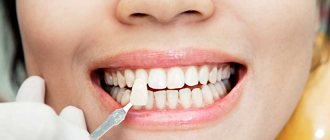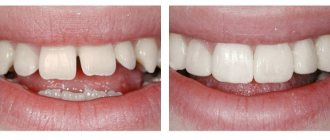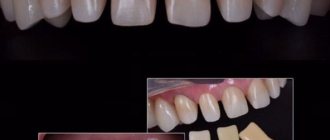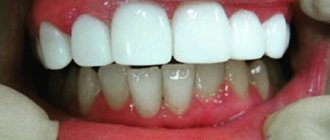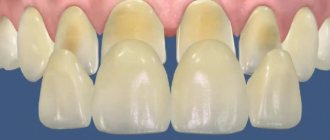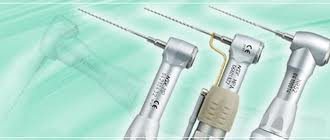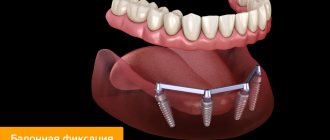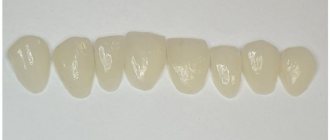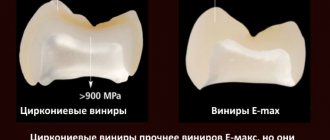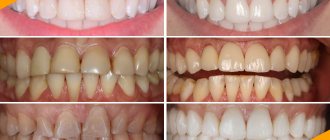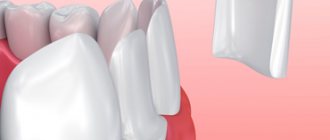What is the difference between a crown and a veneer?
Experts classify both crowns and veneers as orthopedic dentistry, which deals with dental prosthetics. If we talk about the purpose, then in the conventional orthopedic chain “crown-inlay-veneer” the last product is primarily intended to create aesthetics, while crowns and inlays are needed to primarily restore the functionality of the tooth. In dentistry, a separate category is allocated for veneers - microprosthetics, which well reflects the most important visual difference between veneers and crowns. A crown completely copies the entire visible part of a tooth, while veneers model only its outer (vestibular) side.
What veneers and crowns have in common is the fact that both are made in a dental laboratory, but this does not apply to direct composite onlays. In their case, the need for a laboratory stage is eliminated: the application of the composite material is carried out directly in the patient’s mouth, so the procedure does not require taking impressions and is considered an artistic restoration. As for manufacturing materials, there is great variability in crowns. Both designs can be produced from ceramics and zirconium dioxide. However, zirconium veneers are rarely used: zirconium does not adhere well to the teeth, requires significant grinding and looks unnatural.
Possibilities of veneers
A veneer is a thin plate that is glued to a pre-treated tooth surface. It consists of successively formed layers of photopolymer or dental ceramics that qualitatively imitate enamel. For installation, the surface of the outer side of the enamel thickness is ground down to 0.4-0.8 mm, which allows you to build a new one without changing the dimensions. Such facades are an excellent way to eliminate many aesthetic defects:
- ugly color;
- minor problems with bite;
- distortion of shape;
- chips.
The method is used in cases where enamel defects cannot be bleached. As a result, the teeth become straight and smooth, and the smile is irresistible. There are two types of veneers:
- The first ones are formed by the dentist directly on the tooth using a composite material. The time required for the procedure is limited to one visit. The disadvantage is the gradual loss of shine and possible color change.
- The latter are made by a dental technician from porcelain based on impressions taken. Such plates do not change color and look more natural: a good master can achieve pearly translucency, very similar to real enamel.
In the latter case, you will need to come to the doctor's office several times. During the first visit, the dentist grinds down a thin layer of enamel, makes an impression and installs temporary plates. The second visit is to try on the manufactured veneers. If the color scheme or size does not match, they are sent for revision. If everything is in order, they stick.
What is better - veneers or crowns?
Talking about which is better (veneers or crowns) is like comparing a car and a motorcycle. Each of these methods has its own advantages and indications for use. Below is a table that shows situations when it is most preferable to use crowns and when to use veneers.
| Indications for installation of veneers | Indications for crown installation |
|
|
By and large, crowns and veneers have different indications for installation, however, there are situations in which the patient can choose between two products.
Benefits of restoring a tooth with a crown
Dental restoration with crowns has many advantages over fillings.
Protecting remaining tooth tissue from recurrent caries
If a significant part of the tooth is destroyed, the dentist will recommend making a stump inlay and covering the tooth with a crown. This method allows you to save the tooth and protect it from secondary caries. Food does not get under the crown and inlay, and the marginal seal inside is not disturbed. Therefore, the tooth is not destroyed.
A crown is the most reliable way to preserve your “native tooth” from chips and breakages
Weakened hard tooth tissues with thin walls become fragile. In this condition, even a small mechanical impact is enough to cause a microcrack to form and a piece of the tooth to break off (for example, when biting a nut). The crown reliably protects against chips and breaks.
The indirect restoration method improves the quality of restoration
The advantages of the direct method, i.e. fillings – speed and low price. However, the main goal of aesthetic restoration and restoration - preventing the destruction of deep layers, restoring the natural shape of the tooth and maintaining the bite - in this case it is not always possible to achieve, the doctor’s view of the oral cavity is quite limited. In addition, crowns can now be made in 2-3 hours (using Cerec technology).
When making a crown, it is possible to model the anatomically correct shape of the restoration, getting as close as possible to the individual characteristics of the patient’s dental system. When filling, the dentist does not have this option. Also, ceramic microprostheses are more durable, practically do not shrink, are firmly fixed on the crown of the tooth and strengthen the walls, do not wear out, and do not change color. Thanks to the smooth surface of the ceramic, plaque with pathogenic bacteria does not form on it. Crowns provide precise marginal fit, and some have an additional antibacterial effect.
When is the best time to install crowns?
- With significant tooth decay.
From a functional point of view, crowns are considered a more reliable method, so it is better to cover serious chips and damage with crowns. In addition, veneers are strictly not recommended for pulpless teeth. - Frequent participation in contact sports.
If you cannot imagine your life without hockey, basketball or martial arts, it is better to choose more durable crowns to restore your teeth. - Bruxism and the habit of chewing on foreign objects.
In this case, installing veneers is very risky, but even crowns are not able to withstand such loads for a long time, so you need to get rid of bad habits or consult a doctor to treat bruxism.
Photos before and after installation of veneers
What to choose
The choice of a particular product depends on a number of factors. An experienced dentist who can see the condition of the tooth will help you deal with them. General recommendations are as follows:
- The defective element is located in the smile zone, but is not subject to serious damage. In this case, it is better to install veneers, as they look more natural, preserving the nerve of the living tooth.
- If the front tooth is severely damaged, a veneer cannot be installed. Requires a crown.
- for the chewing area, so in such cases the dentist always recommends a crown.
In any case, the choice is made by the patient himself, based on his own preferences and financial capabilities.
When is the best time to install veneers?
- For small defects in the front teeth.
Unlike crowns, veneers require minimal grinding of the teeth, so the tooth retains its anatomical shape. By the way, it is no longer possible to install veneers after crowns; - To hide small interdental spaces and curvatures.
Veneers cope well with such problems and do not require deep tooth preparation.
When restoring chewing teeth, crowns should be installed, as they cope well with the chewing load. Veneers are placed on molars if they want to get an additional lifting effect for the lower third of the face.
The need for crowns
Dental crowns are a form of fixed prosthesis that restores the functionality of a tooth. Their placement is one of the most frequently performed dental procedures and is done when tooth decay or other problems have caused such deep damage that filling treatment is no longer possible.
With the help of a crown installed on the ground part of the tooth, it is given a shape close to the original one, which ensures normal chewing, diction and an aesthetic appearance. The prosthesis replaces the entire external shape of the tooth, right down to the gum level.
Depending on the type and size of the lesion and in accordance with the wishes of the patient, the appropriate type of crown is selected. For example, the front teeth are not subject to heavy loads and should not differ from natural ones. That's why porcelain is used here. Metal alloys are used for prosthetics of chewing molars. They are durable and are made of gold, titanium and various alloys.
Dentists especially love working with gold: its properties make it possible to very accurately adapt the crown to the dental stump. It is resistant to biting and chewing, and the risk of product breakage is minimal. While highly durable, it has the same abrasion resistance as real enamel, so it does not cause excessive damage to opposing teeth. However, there is a significant drawback: metals are very noticeable against the background of natural teeth, so such crowns are usually placed on sixes and sevens, which are not visible in a smile.
Fully ceramic (porcelain) crowns have the property of translucency, which makes them aesthetically more preferable compared to a metal frame. They can be made in such a way that there is no difference between them and natural teeth. This is an excellent choice for the restoration of anterior teeth in the absence of contraindications.
The most popular material is metal ceramics. The two-component nature gives these crowns the strength of metal and the aesthetics of porcelain. During the fabrication process, the technician first creates a metal frame (which rests on the tooth stump) and then covers it with ceramic. Thanks to this, crowns are very similar in appearance to real teeth and are used for restoration and prosthetics, regardless of their location in the mouth. Only a professional can distinguish a well-installed metal-ceramic crown from a natural tooth.
Are veneers used on crowns?
“Is it possible to put veneers on a crown?” — this question is so popular among patients that it has to be discussed separately. The answer here is obvious: veneers are NOT used on crowns. These products are self-sufficient, so such a “mix” makes no sense at all. Repair of crowns is possible, although replacement of the product is more often recommended. Crown restoration is carried out both in the laboratory (the crown is removed beforehand) and directly in the patient’s mouth. The whole procedure is reminiscent of a filling, when the damaged area is filled with a composite material. Veneers cannot be repaired: if the lining breaks, it is replaced with a new one. The exception is direct composite veneers, which can theoretically be restored.
Types of restoration: direct and indirect
Before deciding whether a dental restoration or a crown is better, you need to understand the concept of dental restoration. It comes in the following types:
- Direct restoration. With this method of treatment, various materials are used to give the tooth a certain shape. They are applied to the place that needs to be restored, made into the correct shape and dried using a special light. Usually such procedures are done quickly, the tooth takes on a solid structure, so the cost is usually low.
- Indirect restoration is a method in which crowns or inlays are used. They are made separately in the laboratory, based on the originally made cast. This takes more time, and accordingly the price will be higher.
Types of veneers
Patients often confuse the ceramic look with porcelain. It all depends on the original material, so they are divided into the following types:
- zirconium dioxide crown;
- porcelain.
The latter type is recommended for installation in the case of a single restoration. In most cases, they are not used for bridge prosthetics. The ideal option for any case is dental crowns made of zirconium dioxide. They are suitable for all groups of teeth. The material has unique properties, even ceramic ones are inferior in quality. The devices are in great demand. Despite this, only a doctor can determine whether crowns or veneers will be required.
In most cases, crowns are installed once and for life, so you should not save on your own health.
Service life and cost
Installing crowns will cost 1.5-2 times less than veneers. It is worth understanding that each clinic has its own pricing policy, but you should focus on 8-20 thousand rubles for the installation of one metal-ceramic crown, and 25-50 thousand for the installation of one veneer.
As for the terms of use of crowns, they are not inferior to veneers - metal ceramics can last 15 years.
Once the crown is removed, the tooth will never return to its previous state - the enamel is ground down too much before its installation. Veneers are also installed without the chance of removal, but the tooth enamel suffers less.
When installing veneers and crowns, you should remember that diseases of the oral cavity, including inflammatory ones (periodontitis, gingivitis) must be absent at the time of the procedure. If you start installing veneers during gum inflammation, you can injure soft tissues, which can lead to infection and complications. In the case of caries, you need to make sure that the neighboring teeth (on which microprostheses will not be installed) are not affected by this disease, otherwise it will be more difficult to treat these teeth later. It is possible to remove caries and put fillings on adjacent teeth affected by caries directly during grinding or installation of veneers or crowns, this needs to be clarified by the doctor.
Before installing veneers or crowns, you need to decide on the color so that after the procedure the teeth look as natural as possible and do not stand out from the rest.
The possibility of installing veneers and crowns should be decided by the attending physician, depending on the degree of tooth decay and its position in the oral cavity.
And in this video you can find out what is better to install on your front teeth, veneers or crowns:
If you have any questions or want to add something, leave your comments below.
Dental crowns
Dental crowns are one of the oldest and most popular methods of prosthetics. The finished design looks like a cap. Previously, crowns were used exclusively to restore dental function that could not be restored with fillings. For the manufacture of such structures, alloys of precious and non-ferrous metals were used. They were not aesthetically pleasing, were noticeable and were not always safe.
Over time, ceramics began to be used to make crowns. It had excellent aesthetic properties, but was too fragile. And only in structures made of zirconium dioxide it was possible to combine durability, safety, strength and beauty. It is impossible to notice that the tooth is not real. Zirconium crowns are most often used when it is necessary to change the shape, color or location of a tooth. This material is suitable even for people prone to allergic reactions.
In some cases, the condition of the patient’s teeth allows the installation of any dental structures. A person faces a difficult choice: which is better - veneers or zirconium crowns. It happens that even a dentist cannot clearly answer this question. Each option has its own advantages.
When are veneers used?
Veneers are microprostheses that are installed on teeth in order to visually remove various imperfections, restore the whiteness of your smile and give your teeth an ideal line. If the tooth enamel has darkened or stained, if a tooth has chipped or cracked, if the tooth has not developed properly since childhood, the use of veneers is suitable for these cases. Veneers are installed on the front teeth in the smile line.
Veneers are made from various materials:
- composite compositions - consist of a mixture of various substances; they are shaped directly in the patient’s mouth. The peculiarity of such dental overlays is that they are exposed to coloring substances and may darken over time with use. This is especially true for smokers. As you know, cigarette smoke emits a large amount of tar and harmful impurities, which settle on the teeth, quickly turning them an unpleasant yellow color. Tobacco lovers are not recommended to install composite veneers;
- ceramics (porcelain) - has greater resistance to irritating factors than composites. They retain their original shade throughout the entire period. Ceramic veneers are created in the laboratory using impressions previously taken of patients’ teeth. Accordingly, the speed of installation of this type of veneers is much faster, since there is no need to “sculpt” each tooth. Before installation, the tooth enamel is ground down so that the tooth does not look too bulky along with the onlay. The cost of ceramic veneers is higher, and only professional clinics offer this service, but the service life and reliability are much higher than composite veneers.
There are a number of restrictions when it is not recommended to install veneers:
- malocclusion (reverse);
- tooth enamel is too thin;
- enamel is too sensitive. Installing veneers on such teeth can cause discomfort not only during the installation process itself, but also during operation. Teeth under veneers may begin to hurt and react sharply to temperature changes;
- greater wear of teeth;
- when several teeth are missing (more than 4). In this situation, there is a way out - first do prosthetics, then install veneers;
- when playing sports that can damage your teeth (boxing, wrestling, hockey).
It is strictly forbidden to install a veneer on a pulpless tooth (with a removed nerve). In this case, it is necessary to resort to the procedure of prosthetics with crowns.
In terms of service life, veneers can be worn for quite a long time - up to 15 years, after which they can be replaced with new ones.
